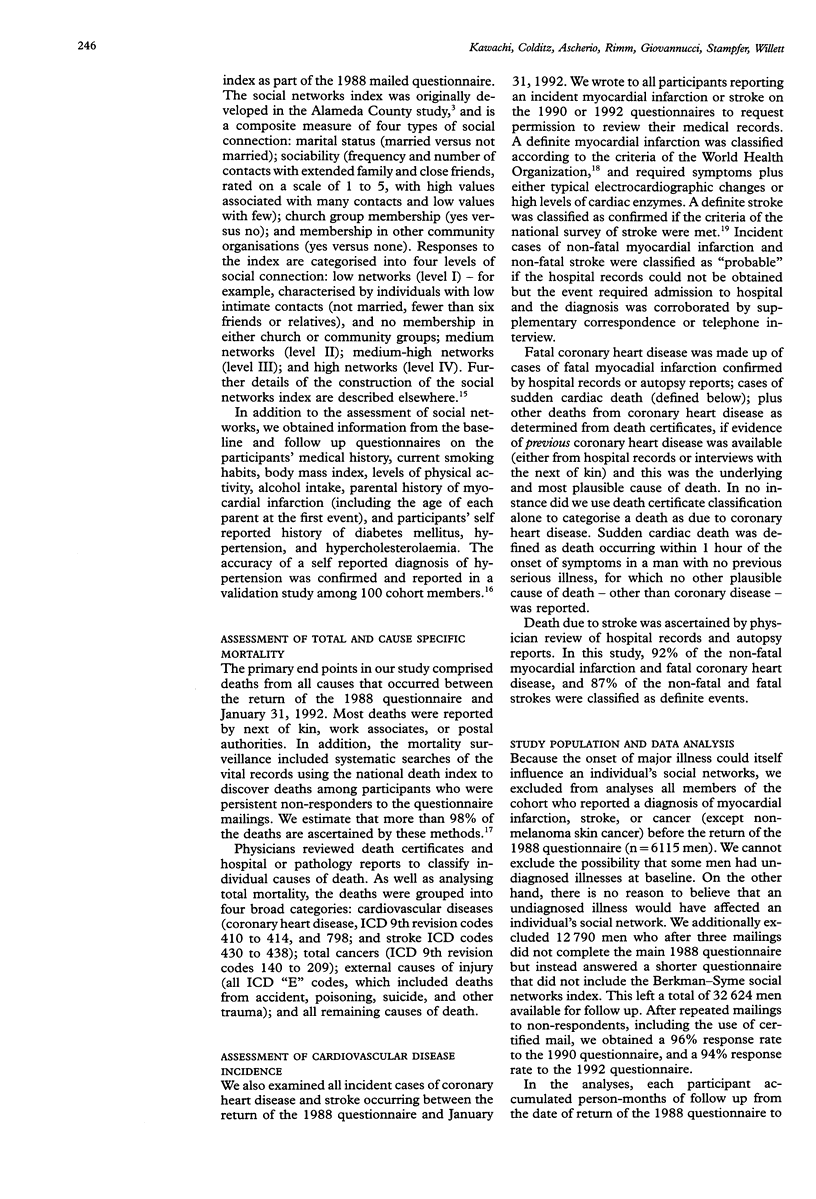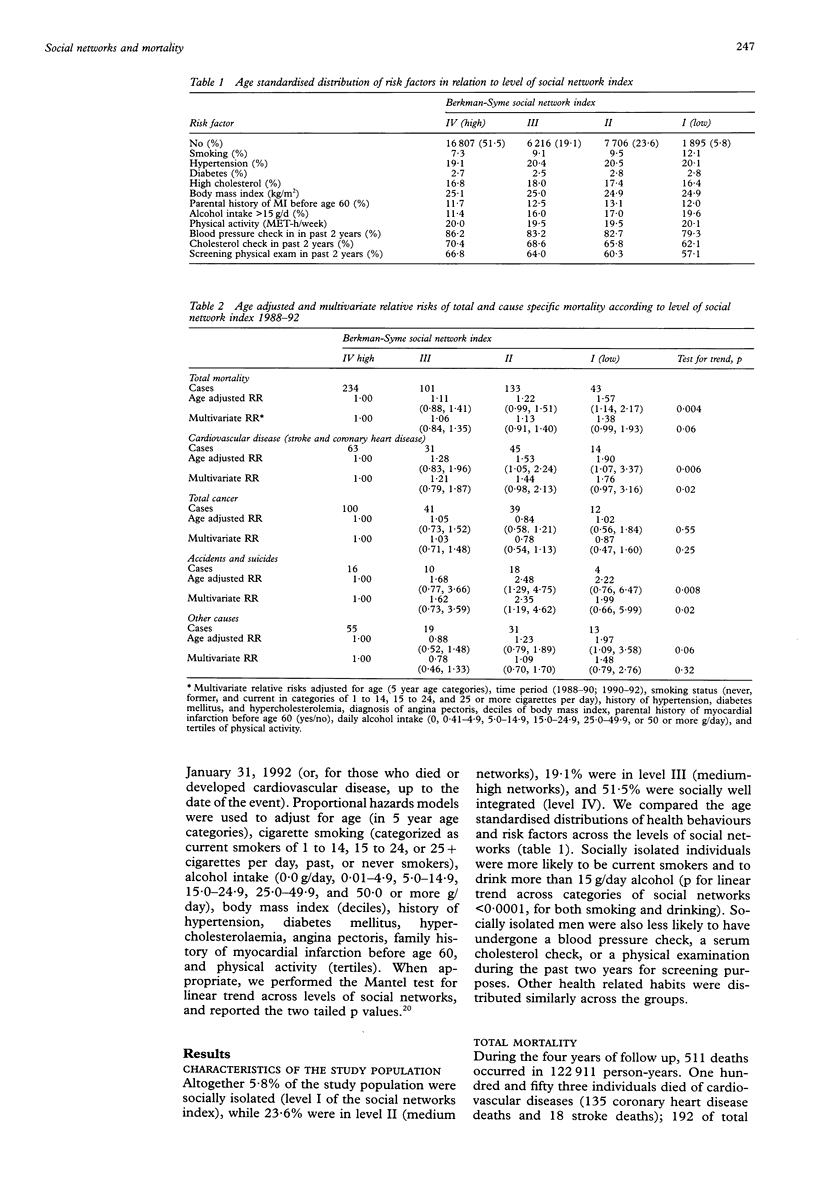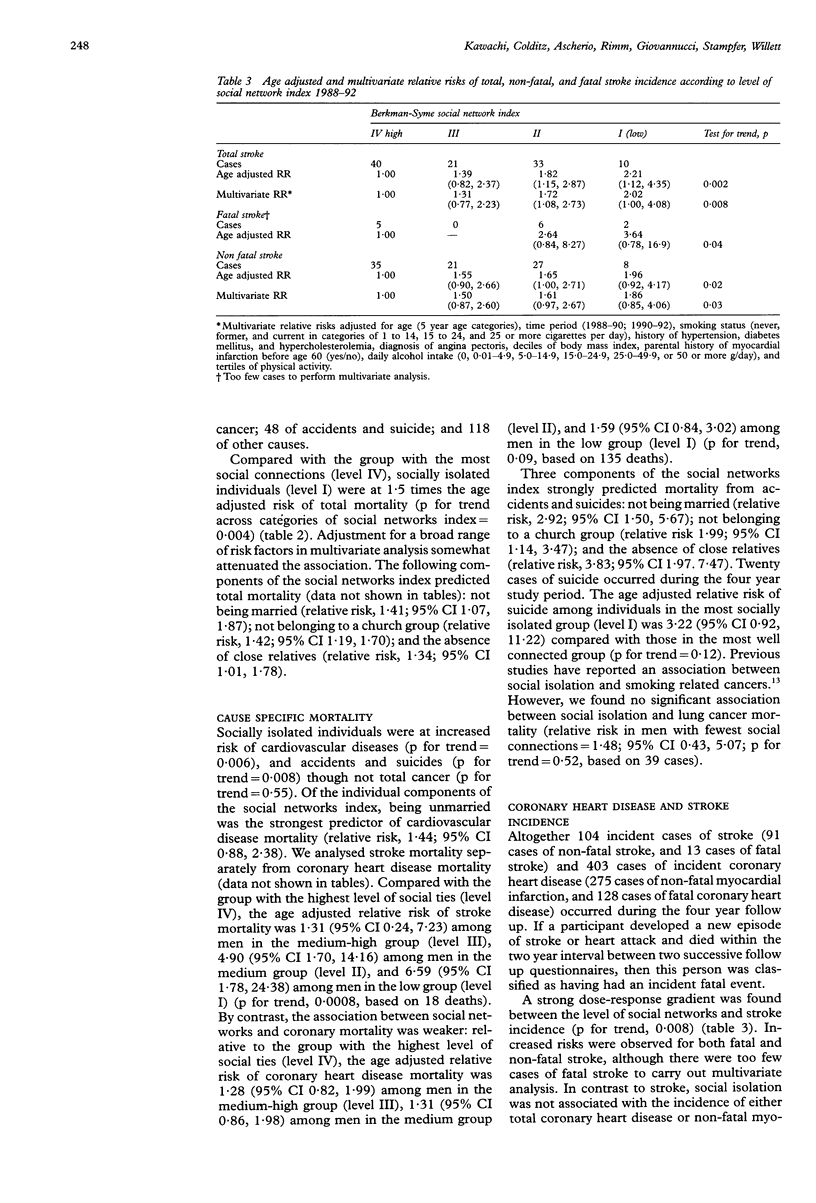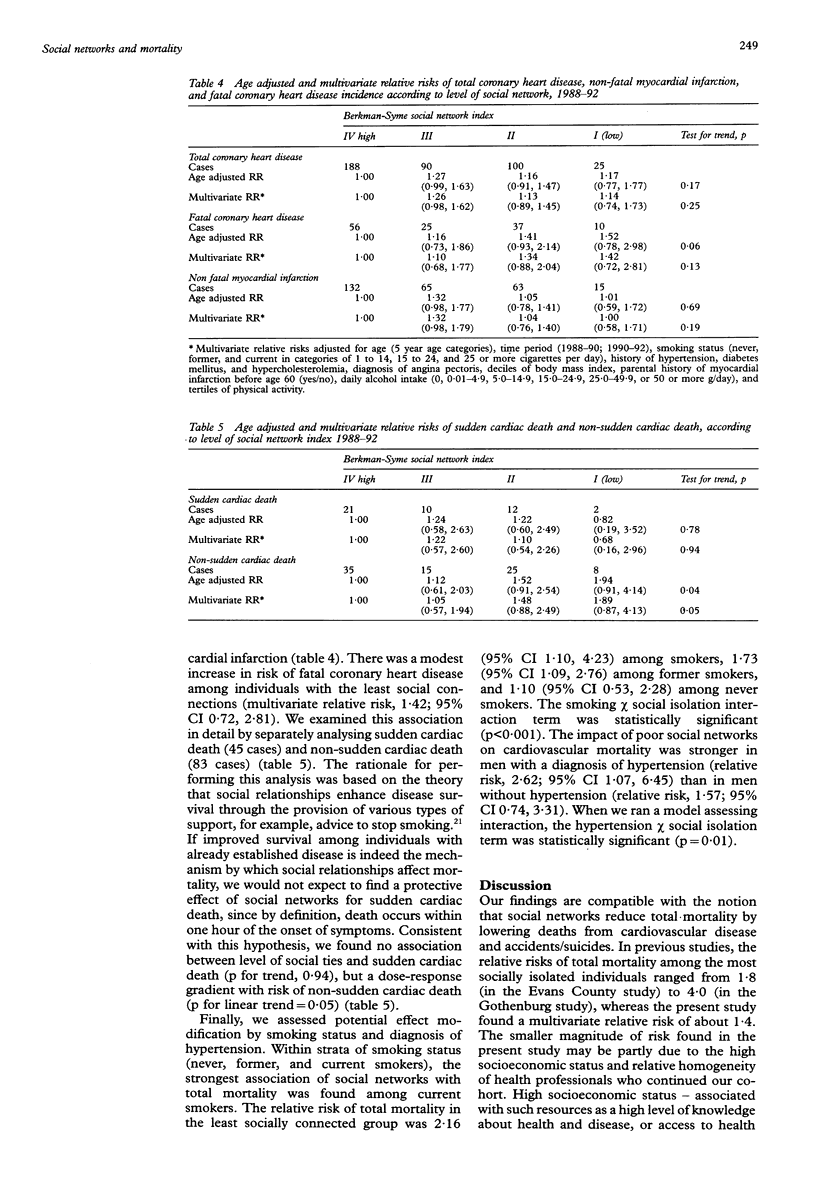Abstract
STUDY OBJECTIVE: Previous studies have established a relationship between low levels of social networks and total mortality, but few have examined cause specific mortality or disease incidence. This study aimed to examine prospectively the relationships between social networks and total and cause specific mortality, as well as cardiovascular disease incidence. DESIGN: This was a four year follow up study in an ongoing cohort of men, for whom information on social networks was collected at baseline. The main outcome measures were total mortality, further categorised into deaths from cardiovascular disease (stroke and coronary heart disease), total cancer, accidents/suicides, and all other causes; as well as stroke and coronary heart disease incidence. PARTICIPANTS: Altogether 32,624 US male health professionals aged 42 to 77 years in 1988, who were free of coronary heart disease, stroke, and cancer at baseline. RESULTS: A total of 511 deaths occurred during 122,911 person years of follow up. Compared with men with the highest level of social networks, socially isolated men (not married, fewer than six friends or relatives, no membership in church or community groups) were at increased risk for cardiovascular disease mortality (age adjusted relative risk, 1.90; 95% CI 1.07, 3.37) and deaths from accidents and suicides (age adjusted relative risk 2.22; 95% CI 0.76, 6.47). No excess risks were found for other causes of death. Socially isolated men were also at increased risk of stroke incidence (relative risk, 2.21; 95% CI, 1.12, 4.35), but not incidence of non-fatal myocardial infarction. CONCLUSIONS: Social networks were associated with lower total mortality by reducing deaths from cardiovascular disease and accidents/suicides. Strong social networks were associated with reduced incidence of stroke, though not of coronary heart disease. However, social networks may assist in prolonging the survival of men with established coronary heart disease.
Full text
PDF






Selected References
These references are in PubMed. This may not be the complete list of references from this article.
- Antonovsky A. Breakdown: a needed fourth step in the conceptual armamentarium of modern medicine. Soc Sci Med. 1972 Oct;6(5):537–544. doi: 10.1016/0037-7856(72)90070-4. [DOI] [PubMed] [Google Scholar]
- Berkman L. F., Leo-Summers L., Horwitz R. I. Emotional support and survival after myocardial infarction. A prospective, population-based study of the elderly. Ann Intern Med. 1992 Dec 15;117(12):1003–1009. doi: 10.7326/0003-4819-117-12-1003. [DOI] [PubMed] [Google Scholar]
- Berkman L. F., Syme S. L. Social networks, host resistance, and mortality: a nine-year follow-up study of Alameda County residents. Am J Epidemiol. 1979 Feb;109(2):186–204. doi: 10.1093/oxfordjournals.aje.a112674. [DOI] [PubMed] [Google Scholar]
- Blazer D. G. Social support and mortality in an elderly community population. Am J Epidemiol. 1982 May;115(5):684–694. doi: 10.1093/oxfordjournals.aje.a113351. [DOI] [PubMed] [Google Scholar]
- Case R. B., Moss A. J., Case N., McDermott M., Eberly S. Living alone after myocardial infarction. Impact on prognosis. JAMA. 1992 Jan 22;267(4):515–519. [PubMed] [Google Scholar]
- Cassel J. The contribution of the social environment to host resistance: the Fourth Wade Hampton Frost Lecture. Am J Epidemiol. 1976 Aug;104(2):107–123. doi: 10.1093/oxfordjournals.aje.a112281. [DOI] [PubMed] [Google Scholar]
- Cassileth B. R., Lusk E. J., Strouse T. B., Miller D. S., Brown L. L., Cross P. A., Tenaglia A. N. Psychosocial status in chronic illness. A comparative analysis of six diagnostic groups. N Engl J Med. 1984 Aug 23;311(8):506–511. doi: 10.1056/NEJM198408233110805. [DOI] [PubMed] [Google Scholar]
- Cobb S. Presidential Address-1976. Social support as a moderator of life stress. Psychosom Med. 1976 Sep-Oct;38(5):300–314. doi: 10.1097/00006842-197609000-00003. [DOI] [PubMed] [Google Scholar]
- DOLL R., HILL A. B. Lung cancer and other causes of death in relation to smoking; a second report on the mortality of British doctors. Br Med J. 1956 Nov 10;2(5001):1071–1081. doi: 10.1136/bmj.2.5001.1071. [DOI] [PMC free article] [PubMed] [Google Scholar]
- Ell K., Nishimoto R., Mediansky L., Mantell J., Hamovitch M. Social relations, social support and survival among patients with cancer. J Psychosom Res. 1992 Sep;36(6):531–541. doi: 10.1016/0022-3999(92)90038-4. [DOI] [PubMed] [Google Scholar]
- Goodwin J. S., Hunt W. C., Key C. R., Samet J. M. The effect of marital status on stage, treatment, and survival of cancer patients. JAMA. 1987 Dec 4;258(21):3125–3130. [PubMed] [Google Scholar]
- House J. S., Landis K. R., Umberson D. Social relationships and health. Science. 1988 Jul 29;241(4865):540–545. doi: 10.1126/science.3399889. [DOI] [PubMed] [Google Scholar]
- House J. S., Robbins C., Metzner H. L. The association of social relationships and activities with mortality: prospective evidence from the Tecumseh Community Health Study. Am J Epidemiol. 1982 Jul;116(1):123–140. doi: 10.1093/oxfordjournals.aje.a113387. [DOI] [PubMed] [Google Scholar]
- Kaplan G. A., Keil J. E. Socioeconomic factors and cardiovascular disease: a review of the literature. Circulation. 1993 Oct;88(4 Pt 1):1973–1998. doi: 10.1161/01.cir.88.4.1973. [DOI] [PubMed] [Google Scholar]
- Kaplan G. A., Salonen J. T., Cohen R. D., Brand R. J., Syme S. L., Puska P. Social connections and mortality from all causes and from cardiovascular disease: prospective evidence from eastern Finland. Am J Epidemiol. 1988 Aug;128(2):370–380. doi: 10.1093/oxfordjournals.aje.a114977. [DOI] [PubMed] [Google Scholar]
- McEwen B. S., Stellar E. Stress and the individual. Mechanisms leading to disease. Arch Intern Med. 1993 Sep 27;153(18):2093–2101. [PubMed] [Google Scholar]
- Orth-Gomér K., Johnson J. V. Social network interaction and mortality. A six year follow-up study of a random sample of the Swedish population. J Chronic Dis. 1987;40(10):949–957. doi: 10.1016/0021-9681(87)90145-7. [DOI] [PubMed] [Google Scholar]
- Reed D., McGee D., Yano K., Feinleib M. Social networks and coronary heart disease among Japanese men in Hawaii. Am J Epidemiol. 1983 Apr;117(4):384–396. doi: 10.1093/oxfordjournals.aje.a113557. [DOI] [PubMed] [Google Scholar]
- Reynolds P., Kaplan G. A. Social connections and risk for cancer: prospective evidence from the Alameda County Study. Behav Med. 1990 Fall;16(3):101–110. doi: 10.1080/08964289.1990.9934597. [DOI] [PubMed] [Google Scholar]
- Schoenbach V. J., Kaplan B. H., Fredman L., Kleinbaum D. G. Social ties and mortality in Evans County, Georgia. Am J Epidemiol. 1986 Apr;123(4):577–591. doi: 10.1093/oxfordjournals.aje.a114278. [DOI] [PubMed] [Google Scholar]
- Seeman T. E., Berkman L. F., Kohout F., Lacroix A., Glynn R., Blazer D. Intercommunity variations in the association between social ties and mortality in the elderly. A comparative analysis of three communities. Ann Epidemiol. 1993 Jul;3(4):325–335. doi: 10.1016/1047-2797(93)90058-c. [DOI] [PubMed] [Google Scholar]
- Stampfer M. J., Willett W. C., Speizer F. E., Dysert D. C., Lipnick R., Rosner B., Hennekens C. H. Test of the National Death Index. Am J Epidemiol. 1984 May;119(5):837–839. doi: 10.1093/oxfordjournals.aje.a113804. [DOI] [PubMed] [Google Scholar]
- Syme S. L., Berkman L. F. Social class, susceptibility and sickness. Am J Epidemiol. 1976 Jul;104(1):1–8. doi: 10.1093/oxfordjournals.aje.a112268. [DOI] [PubMed] [Google Scholar]
- Vogt T. M., Mullooly J. P., Ernst D., Pope C. R., Hollis J. F. Social networks as predictors of ischemic heart disease, cancer, stroke and hypertension: incidence, survival and mortality. J Clin Epidemiol. 1992 Jun;45(6):659–666. doi: 10.1016/0895-4356(92)90138-d. [DOI] [PubMed] [Google Scholar]
- Welin L., Tibblin G., Svärdsudd K., Tibblin B., Ander-Peciva S., Larsson B., Wilhelmsen L. Prospective study of social influences on mortality. The study of men born in 1913 and 1923. Lancet. 1985 Apr 20;1(8434):915–918. doi: 10.1016/s0140-6736(85)91684-8. [DOI] [PubMed] [Google Scholar]
- Williams R. B., Barefoot J. C., Califf R. M., Haney T. L., Saunders W. B., Pryor D. B., Hlatky M. A., Siegler I. C., Mark D. B. Prognostic importance of social and economic resources among medically treated patients with angiographically documented coronary artery disease. JAMA. 1992 Jan 22;267(4):520–524. [PubMed] [Google Scholar]


